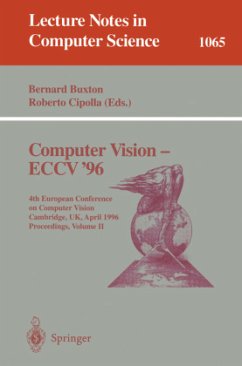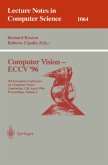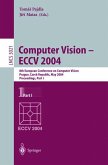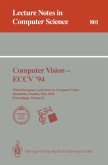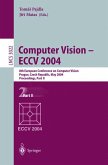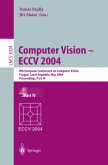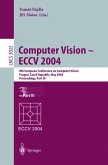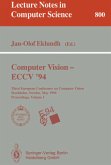BuxtonFourth European Conference on Computer Vision, Cambridge, UK April 14-18, 1996. Proceedings, Volume II
Computer Vision - ECCV '96
Fourth European Conference on Computer Vision, Cambridge, UK April 14-18, 1996. Proceedings, Volume II
Mitarbeit:Buxton, Bernard; Cipolla, Roberto
BuxtonFourth European Conference on Computer Vision, Cambridge, UK April 14-18, 1996. Proceedings, Volume II
Computer Vision - ECCV '96
Fourth European Conference on Computer Vision, Cambridge, UK April 14-18, 1996. Proceedings, Volume II
Mitarbeit:Buxton, Bernard; Cipolla, Roberto
- Broschiertes Buch
- Merkliste
- Auf die Merkliste
- Bewerten Bewerten
- Teilen
- Produkt teilen
- Produkterinnerung
- Produkterinnerung
The European Conference on Computer Vision (ECCV) has established itself as a major event in this exciting and very active field of research and development. These refereed two-volume proceedings include the 123 papers accepted for presentation at the 4th ECCV, held in Cambridge, UK, in April 1996; these papers were selected from a total of 328 submissions and together give a well-balanced reflection of the state of the art in computer vision.
The papers in volume II are grouped in sections on color vision and shading; image features; motion; medical applications; tracking; applications and…mehr
Andere Kunden interessierten sich auch für
![Computer Vision - ECCV '96 Computer Vision - ECCV '96]() Computer Vision - ECCV '9677,99 €
Computer Vision - ECCV '9677,99 €![Computer Vision - ECCV 2004 Computer Vision - ECCV 2004]() Tomas Pajdla / Jiri Matas (eds.)Computer Vision - ECCV 200477,99 €
Tomas Pajdla / Jiri Matas (eds.)Computer Vision - ECCV 200477,99 €![Computer Vision - ECCV '94 Computer Vision - ECCV '94]() EklundhComputer Vision - ECCV '9439,99 €
EklundhComputer Vision - ECCV '9439,99 €![Computer Vision - ECCV 2004 Computer Vision - ECCV 2004]() Tomas Pajdla / Jiri Matas (eds.)Computer Vision - ECCV 200477,99 €
Tomas Pajdla / Jiri Matas (eds.)Computer Vision - ECCV 200477,99 €![Computer Vision - ECCV 2004 Computer Vision - ECCV 2004]() Tomas Pajdla / Jiri Matas (eds.)Computer Vision - ECCV 200477,99 €
Tomas Pajdla / Jiri Matas (eds.)Computer Vision - ECCV 200477,99 €![Computer Vision - ECCV 2004 Computer Vision - ECCV 2004]() Tomas Pajdla / Jiri Matas (eds.)Computer Vision - ECCV 200477,99 €
Tomas Pajdla / Jiri Matas (eds.)Computer Vision - ECCV 200477,99 €![Computer Vision - ECCV '94 Computer Vision - ECCV '94]() Computer Vision - ECCV '9477,99 €
Computer Vision - ECCV '9477,99 €-
-
-
The European Conference on Computer Vision (ECCV) has established itself as a major event in this exciting and very active field of research and development. These refereed two-volume proceedings include the 123 papers accepted for presentation at the 4th ECCV, held in Cambridge, UK, in April 1996; these papers were selected from a total of 328 submissions and together give a well-balanced reflection of the state of the art in computer vision.
The papers in volume II are grouped in sections on color vision and shading; image features; motion; medical applications; tracking; applications and recognition; calibration, focus, and optics; applications; and structure from motion.
Hinweis: Dieser Artikel kann nur an eine deutsche Lieferadresse ausgeliefert werden.
The papers in volume II are grouped in sections on color vision and shading; image features; motion; medical applications; tracking; applications and recognition; calibration, focus, and optics; applications; and structure from motion.
Hinweis: Dieser Artikel kann nur an eine deutsche Lieferadresse ausgeliefert werden.
Produktdetails
- Produktdetails
- Lecture Notes in Computer Science 1065
- Verlag: Springer / Springer Berlin Heidelberg / Springer, Berlin
- Artikelnr. des Verlages: 978-3-540-61123-3
- 1996.
- Seitenzahl: 752
- Erscheinungstermin: 4. April 1996
- Englisch
- Abmessung: 235mm x 155mm x 41mm
- Gewicht: 1122g
- ISBN-13: 9783540611233
- ISBN-10: 3540611231
- Artikelnr.: 09255091
- Herstellerkennzeichnung
- Springer-Verlag GmbH
- Tiergartenstr. 17
- 69121 Heidelberg
- ProductSafety@springernature.com
- Lecture Notes in Computer Science 1065
- Verlag: Springer / Springer Berlin Heidelberg / Springer, Berlin
- Artikelnr. des Verlages: 978-3-540-61123-3
- 1996.
- Seitenzahl: 752
- Erscheinungstermin: 4. April 1996
- Englisch
- Abmessung: 235mm x 155mm x 41mm
- Gewicht: 1122g
- ISBN-13: 9783540611233
- ISBN-10: 3540611231
- Artikelnr.: 09255091
- Herstellerkennzeichnung
- Springer-Verlag GmbH
- Tiergartenstr. 17
- 69121 Heidelberg
- ProductSafety@springernature.com
Colour constancy for scenes with varying illumination.- Color angular indexing.- Bidirectional reflection distribution function expressed in terms of surface scattering modes.- Generalizing Lambert's Law for smooth surfaces.- Local scale control for edge detection and blur estimation.- Regularization, scale-space, and edge detection filters.- Direct differential range estimation using optical masks.- Generalised epipolar constraints.- Object models from contour sequences.- Directions of motion fields are hardly ever ambiguous.- Euclidean reconstruction: From paraperspective to perspective.- Optical flow and phase portrait methods for environmental satellite image sequences.- Refinement of optical flow estimation and detection of motion edges.- Reliable extraction of the camera motion using constraints on the epipole.- Accuracy vs. efficiency trade-offs in optical flow algorithms.- Rigorous bounds for two-frame structure from motion.- The rank 4 constraint in multiple (?3) view geometry.- Using singular displacements for uncalibrated monocular visual systems.- Duality of multi-point and multi-frame geometry: Fundamental shape matrices and tensors.- On the appropriateness of camera models.- Ground plane motion camera models.- Snakes and splines for tracking non-rigid heart motion.- Local quantitative measurements for cardiac motion analysis.- Application of model based image interpretation methods to diabetic neuropathy.- Global alignment of MR images using a scale based hierarchical model.- Reconstruction of blood vessel networks from x-ray projections and a vascular catalogue.- Combining multiple motion estimates for vehicle tracking.- Visual surveillance monitoring and watching.- A robust active contour model for natural scene contour extraction with automatic thresholding.- A maximum-likelihood approach to visual event classification.- Measures for silhouettes resemblance and representative silhouettes of curved objects.- Real-time lip tracking for audio-visual speech recognition applications.- Matching object models to segments from an optical flow field.- Quantification of articular cartilage from MR images using active shape models.- Direct methods for self-calibration of a moving stereo head.- Dense reconstruction by zooming.- Telecentric optics for computational vision.- Recognition, pose and tracking of modelled polyhedral objects by multi-ocular vision.- Locating objects of varying shape using statistical feature detectors.- Generation of semantic regions from image sequences.- Tracking of occluded vehicles in traffic scenes.- Imposing hard constraints on soft snakes.- X Vision: Combining image warping and geometric constraints for fast visual tracking.- Human body tracking by monocular vision.- Computational perception of scene dynamics.- A filter for visual tracking based on a stochastic model for driver behaviour.- Elastically adaptive deformable models.- Statistical feature modelling for active contours.- Motion deblurring and super-resolution from an image sequence.- Uncalibrated visual tasks via linear interaction.- Finding naked people.- Acquiring visual-motor models for precision manipulation with robot hands.- A system for reconstruction of missing data in image sequences using sampled 3D AR models and MRF motion priors.- Elimination of specular surface-reflectance using polarized and unpolarized light.- Separating real and virtual objects from their overlapping images.- Goal-directed video metrology.- Reconstructing polyhedral models of architectural scenes from photographs.- Algebraic varieties in multiple view geometry.- 3D model acquisition from extended image sequences.- Computing structure and motion of general 3D curves from monocular sequences of perspective images.- A factorization based algorithm for multi-image projective structure and motion.
Colour constancy for scenes with varying illumination.- Color angular indexing.- Bidirectional reflection distribution function expressed in terms of surface scattering modes.- Generalizing Lambert's Law for smooth surfaces.- Local scale control for edge detection and blur estimation.- Regularization, scale-space, and edge detection filters.- Direct differential range estimation using optical masks.- Generalised epipolar constraints.- Object models from contour sequences.- Directions of motion fields are hardly ever ambiguous.- Euclidean reconstruction: From paraperspective to perspective.- Optical flow and phase portrait methods for environmental satellite image sequences.- Refinement of optical flow estimation and detection of motion edges.- Reliable extraction of the camera motion using constraints on the epipole.- Accuracy vs. efficiency trade-offs in optical flow algorithms.- Rigorous bounds for two-frame structure from motion.- The rank 4 constraint in multiple (?3) view geometry.- Using singular displacements for uncalibrated monocular visual systems.- Duality of multi-point and multi-frame geometry: Fundamental shape matrices and tensors.- On the appropriateness of camera models.- Ground plane motion camera models.- Snakes and splines for tracking non-rigid heart motion.- Local quantitative measurements for cardiac motion analysis.- Application of model based image interpretation methods to diabetic neuropathy.- Global alignment of MR images using a scale based hierarchical model.- Reconstruction of blood vessel networks from x-ray projections and a vascular catalogue.- Combining multiple motion estimates for vehicle tracking.- Visual surveillance monitoring and watching.- A robust active contour model for natural scene contour extraction with automatic thresholding.- A maximum-likelihood approach to visual event classification.- Measures for silhouettes resemblance and representative silhouettes of curved objects.- Real-time lip tracking for audio-visual speech recognition applications.- Matching object models to segments from an optical flow field.- Quantification of articular cartilage from MR images using active shape models.- Direct methods for self-calibration of a moving stereo head.- Dense reconstruction by zooming.- Telecentric optics for computational vision.- Recognition, pose and tracking of modelled polyhedral objects by multi-ocular vision.- Locating objects of varying shape using statistical feature detectors.- Generation of semantic regions from image sequences.- Tracking of occluded vehicles in traffic scenes.- Imposing hard constraints on soft snakes.- X Vision: Combining image warping and geometric constraints for fast visual tracking.- Human body tracking by monocular vision.- Computational perception of scene dynamics.- A filter for visual tracking based on a stochastic model for driver behaviour.- Elastically adaptive deformable models.- Statistical feature modelling for active contours.- Motion deblurring and super-resolution from an image sequence.- Uncalibrated visual tasks via linear interaction.- Finding naked people.- Acquiring visual-motor models for precision manipulation with robot hands.- A system for reconstruction of missing data in image sequences using sampled 3D AR models and MRF motion priors.- Elimination of specular surface-reflectance using polarized and unpolarized light.- Separating real and virtual objects from their overlapping images.- Goal-directed video metrology.- Reconstructing polyhedral models of architectural scenes from photographs.- Algebraic varieties in multiple view geometry.- 3D model acquisition from extended image sequences.- Computing structure and motion of general 3D curves from monocular sequences of perspective images.- A factorization based algorithm for multi-image projective structure and motion.

